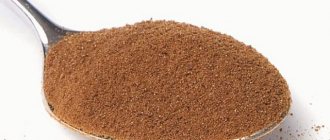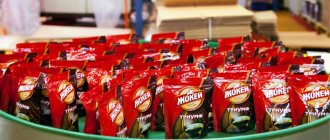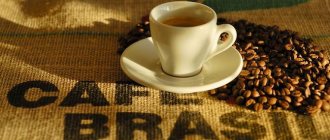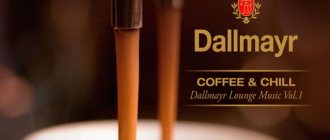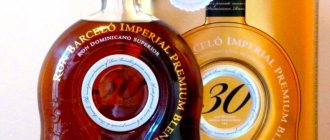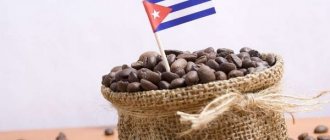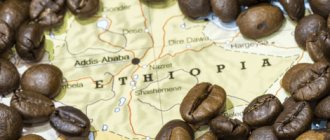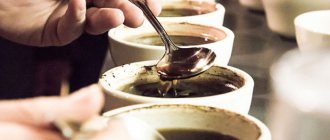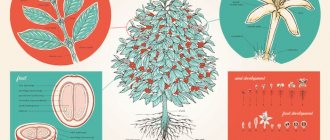| View: | liberica |
| Processing method: | dry |
| Region: | Biolley, province of Puntarenas |
| Garden: | Coffea diversa |
| Growing height: | 1250-1300 meters above sea level |
| Variety: | Excel |
| Package: | grain-pro |
| Harvest: | 2016/2017 |
| Grain Potential: Grain Potential (maximum 100 points) is the SCAA rating of a variety by Ilya Savinov, a certified Q-grader. Please note that SCAA ratings are issued exclusively during cupping of light roasted varieties. | 84.00 (SCA is developed only for Arabicas, but will help to understand the approximate level of Liberica in comparison with Arabicas) |
Origin of the variety
Liberian coffee originates from West Africa. Today, this species is grown in almost all countries of the African continent, as well as on the islands of Sri Lanka, Indonesia, the Philippines and others. Liberica coffee is obtained from the fruits of coffee trees with very large leaves and a height of 6-10 meters. The length of the coffee bean is 30-35 mm, its width is 10-15 mm. Liberica is resistant to all diseases of coffee trees, except rust fungus. The quality of Liberica fruits is not the highest, the yields are very low, so it is rarely used as a separate variety of coffee. Liberica is most often used to create various mixtures.
How to grow Liberica
The Liberica coffee tree differs from other types of flora in its beauty. The usual height of the plant is about 6-8 meters, but sometimes it reaches a length of 10 meters. The tree has large, beautiful leaves that look like a fan. The length of one coffee bean is 3-4 centimeters, width - 1-1.5 centimeters.
For the plant to begin to bear fruit, the climate must be hot and humid. If the conditions are not met, the tree does not die, but stops producing crops. After heavy rains, Liberica revives and begins to bear fruit again.
The plant does not require special care. It is resistant to diseases and is not afraid of insects; it does not require special care or treatment. From a cultivation point of view, the variety is very economical, although it has low yield.
In Malaysia
The only place in the world where this type of coffee occupies the overwhelming area of plantations (more than 90%) is Malaysia. The country produces approximately 10,000 tons of beans per year, a volume that accounts for 0.01% of the global coffee market.
Ripe fruits are collected using the picking method (only ripe berries are carefully removed by hand). The technology makes it possible to achieve a uniform harvest. This coffee is considered the highest grade and has a rich taste.
Have you tried drinks with Liberica coffee?
Yes
No
The local population prefers Liberica; imported varieties are not popular with them. The grains of the plant are processed using wet or honey methods. In Malaysian cafes - kopitiams - you can try traditional Liberica drinks. There are several popular recipes, for example: grains are caramelized over fire in sugar, which gives the drink a peculiar sweetish taste. Ipoh “white” coffee, which is roasted in butter, is also popular.
In the Philippines
Locals call this coffee Barako (Kapeng Barako). After severe frosts in 1886-1888, which destroyed Arabica and Robusta coffee plantations in Latin America, the time of Philippine liberica came. Grains began to be supplied to neighboring countries and the share of production increased significantly. But, in the first decades of the 20th century, the variety began to lose popularity, and the more productive robusta began to be used instead.
In the 90s of the 20th century, Philippine liberica completely lost its glory. The reason was the activities of unscrupulous businessmen who mixed Barako with cheap Vietnamese excelsa. The consumer did not like the flavor combination; the drink turned out bitter and “empty.” So farmers began removing liberica from their fields and replanting them with more profitable coffee varieties. For the last 20 years, they have been trying to restore Barako in the Philippines.
In Sri Lanka
Coffee on the island is not a very common product, so it is very valuable. Until the second half of the 19th century, Sri Lanka was known for its high-quality grain drink, but after the appearance of the fungus Hemileia vastatrix on the island, the plants died. To avoid financial distress, coffee trees were replaced by tea bushes and Ceylon gained fame as the Tea Empire.
Currently, the humid and warm climate allows Liberica to be propagated on the island without hassle. Trees are not planted on plantations on purpose, but grow in the natural environment. In Sri Lanka, this variety is not consumed in its pure form; it is added to coffee combinations to make the taste of the drink deeper and more interesting.
History of the Liberica variety
This type of coffee was discovered for widespread use only in the 20th century. in Guinea. It was found at the end of the 18th century in the forests of Liberia (hence the name of this species) by Carl Linnaeus' student Adam Afzelius. Later, this species was found in Cote D'Ivoire. Of all the existing botanical varieties of coffee trees, Liberica trees are the most slender and tall (height can reach 18 meters). This coffee tree grows only north of the equator and is very difficult to find on plantations. Liberica makes up only 2% of the coffee trees grown on coffee plantations. However, the reason for such unpopularity of this botanical variety is not at all the climatic preferences of the Liberica coffee tree - the drink made from Liberica beans has an unsaturated, “empty” taste and is not in demand among coffee lovers. The caffeine content of Liberica can vary from 0.7% to 2.4%. This type of coffee is used mainly in the confectionery industry, therefore, when talking about the types of coffee used to prepare the popular drink, liberica is usually not mentioned at all.
How is Liberica used?
This type of coffee is rarely sold in its pure form. Due to the bitter taste and lack of an invigorating effect, the drink does not have many fans. Liberica is often used in production:
- Coffee blends , which can consist of Arabica, Robusta and a small portion of Liberica. Without Robusta, the drink loses strength, without Arabica it turns out too bitter, and without Liberica it is not so aromatic.
- Jasmine tea . During flowering, Liberian coffee has a jasmine aroma. Therefore, dried flowers are added to tea as a natural flavor enhancer.
- Confectionery products . Liberica gives cakes and cakes a pleasant smell of fresh coffee. Natural flavoring does not add an invigorating effect to baked goods, because... the beans contain small amounts of caffeine.
- Instant coffee . It is added to other varieties to make the taste more pronounced.
Conclusions:
- Liberica is the third most popular coffee variety in the world.
- In its pure form it is used only locally and is mainly exported.
- The grains are very large, up to 3.5 cm in length, in appearance - the same as Arabica, just larger.
- The natural taste is weak, watery, sharply bitter. But the natural aroma is stronger than that of other varieties.
- Used primarily to enhance the aroma in coffee blends, as well as in the confectionery industry, the flowers are used to make tea with a strong jasmine aroma.
The present and future of Liberica
The same problem happened with Liberica as with Robusta: almost everywhere, except Malaysia, they stopped monitoring the quality of the grains and the thoroughness of their processing. It is not surprising that in many countries Liberica plantations are on the verge of destruction.
Over the past few years, there has been a real liberica renaissance. It turned out that it is not so low-yielding: if the cultivation and harvesting technology is followed, 5 kg of green coffee beans per year are obtained from one tree, up to 4 tons per hectare.
Premium Liberica is popular with coffee lovers. Most popular brands:
- India Anohki Coffe – 100% Liberica with hints of chocolate, honey and anise on the palate;
- My Liberica (Malaysia) - a whole line of 100% liberica, which includes honey-processed peaberries (with nutty and jasmine notes in the taste), regular light roast beans (with a taste of jasmine and milk chocolate), wet-processed, and dark roast coffee.
Classification of coffee by variety
There are a huge number of varieties based on Arabica, Robusta and their hybrids in the world. It is impossible to list everything, but the varieties can be divided into two large groups.
- Widespread varieties. For example, Bourbon, Antigua, Supremo, Santos. The same variety can be grown in different countries, such as Brazil, Vietnam and Indonesia. In this case, its origin is added to the name of the variety. For example, Peaberry Tanzania or Maragogyp Brazil.
- Exclusive single varieties that are produced in a certain area or using a certain technology. For example, Malabar Monsoon is Indian coffee with partial fermentation under the influence of monsoon winds, and Old Java is artificially aged Indonesian coffee.
Classification by geography of origin
About 80 countries grow coffee, and approximately 50 of them export beans. For ease of classification, coffee is divided into groups according to growing regions.
South America
South America produces half of the world's grain supply. Brazil produces a large volume of coffee, most varieties are hybrid, but there are also good examples of typical Arabica coffee. The import of robusta is prohibited by law in Colombia, so only Arabica, which has a rather mild taste, is grown here. Peru and Ecuador provide the world with high quality single varieties grown on the slopes of the Andes and in intermountain valleys. Coffee grows in Venezuela, Paraguay, Chile. Many gourmets find South American coffee lacking in expression, with a few pleasant exceptions from Peru, Ecuador and Venezuela.
Central America
Mexico provides large volumes of grains for mixtures and blends; there are many productive but coarse varieties. But Honduras and Guatemala, Costa Rica and Cuba, Jamaica and Nicaragua are famous for their single varieties of excellent quality. Coffee from this region is distinguished by its richness and variety of flavor profiles.
Africa
The ancient homeland of coffee. African coffee is famous for its rich taste and piquant flavor notes. Authentic coffee grows in Ethiopia; it has not been subjected to any cultivation and has retained its natural taste. Ugandan varieties compete with the famous Jamaican coffee, Kenya produces soft and rich Arabica, and Congo produces hybrid varieties with a bright taste.
Asia and Oceania
Many old varieties of Arabica are grown in Asia, which are no longer available in America, where they were destroyed by coffee rust. Classic Arabica beans are cultivated in Yemen. Coffee from the Indonesian islands of Java and Sulawesi is considered one of the best in the world. India is another cradle of coffee, producing both industrial blends and excellent old single varieties.
Comparison with Arabica and Robusta
You can compare Arabica, Robusta and Liberica in several ways:
- Grain size.
- Taste qualities.
- Aroma.
- Caffeine content.
Liberica beans are larger than the finest Arabica varieties. Its length is 3.5 cm and its width is 1.5 cm. Few people have seen these fruits with their own eyes, since it is not sold anywhere in its pure form - liberica is used in the countries where it grows. Considering that Robusta is smaller than Arabica, Liberica is 3 times larger in size.
Robusta is the leader in caffeine content. This is the strongest variety. It contains 3 times more than Liberica, which means the invigorating effect is difficult to achieve. Arabica beans have different caffeine content depending on the variety and place of cultivation, so on average the amount of alkaloid is 2 times less.
Video: Features of the Liberica variety
In terms of taste, Liberian coffee is the most watery variety. It is not of interest for any special notes of taste, so it is not grown. But Liberian grains have a very dense aroma. Of interest are the flowers of the tree, which are exactly like jasmine.
What to choose? Arabica, Robusta or Liberica? Did you know about Excelsa? In this article we will talk in detail about all types of coffee trees!
Before we talk about the different types, it is worth talking a little about the coffee tree itself. From a botany point of view, “coffee” or “coffee tree” (lat. Coffea) is a genus of evergreen plants of the tribe Coffeeaceae (a tribe is a rank in biological taxonomy, standing in the hierarchy below the family, but above the genus), the Rubiaceae family.
They live wild in the highlands of tropical Africa and Asia, and are cultivated throughout the tropics. Most of them are small trees or large shrubs, up to 8 meters high. In indoor conditions, they often take the form of a bush. All parts of the plant contain caffeine, which serves as a pest repellent. However, some species may contain quite a lot of it, while others may contain very little.
Coffee blooms with small white flowers with a strong tropical scent. The flower contains both male and female reproductive organs (that is, pistils and stamens) and is capable of self-pollination.
The berries ripen within 3-4 months, and when ripe they are bright red or burgundy ellipsoids with 1-3 grains inside, sitting on a short stalk directly on the branch. Under the pulp are seeds, the color of which before processing is yellowish-greenish-gray.
So, now let's move directly to the types of coffee tree. There are four of them - Arabica, Robusta, Liberica and Excelsa. The most interesting from a commercial point of view are two types - Arabica and Robusta. These most famous species of coffee trees produce more than 90% of the coffee consumed.
Arabica
Robusta
Liberica
Excelsa
Seeds, or beans, of coffee from different plantations have completely different distinctive characteristics, namely aroma, caffeine content, density, taste and acidity. Such properties depend not only on the variety or cultivar of coffee, but to a greater extent on the environment - the area of growth and the quality of soil cultivation. Thus, the taste of coffee shows a clear affiliation of the variety to a particular region.
Most varieties(!) are hybrids or mutations of natural varieties. Of all, there are two main varieties: typica and bourbon.
Typica
Typica is a foundation variety that was discovered centuries ago in the Kaffa region of Ethiopia. It was brought to America by a French naval officer at the beginning of the 18th century. Based on Typica, other varieties appeared by mutation, such as Jamaica Blue Mountain, San Ramon, Villalobus, Java, Jember. Trees of this variety are conical in shape with a main trunk from which branches extend at a slope of 50-70 degrees. Also a distinctive feature is the low yield of Typica, which increases its value in the market. Cup quality is generally excellent, with outstanding sweetness, clarity and body.
Bourbon
This variety gets its name from the island of Bourbon (now Reunion), located off the east coast of Madagascar. It is a natural mutation of early Arabica beans from Ethiopia and Yemen. Bourbon began to be cultivated by the French in 1708. It is the basis of a large number of varieties, for example, Kent, Jackson, Arusha and others. Bourbon coffee trees produce 20-30% more yield than Typica. The leaves of the variety are wide and wavy at the edges. Berries can be red, yellow and orange. The cup has complex acidity and stunning balance. Low-growing trees are grown on cultivated plantations - they are not only more productive, they are more convenient to process and harvest. The branches of the coffee tree are almost horizontal, the leaves are oblong, dark green, shiny, up to 30 cm in length, hanging on the trees for 3 to 5 years. White tubular, up to 2 cm long, fragrant flowers are borne in their axils. The fruits are similar to stone fruits - the size of a large cherry, with two seeds, red or black and blue. Sometimes one large seed ripens in the fruit. Such grains are collected separately, called pearl grains , and are especially valued by connoisseurs. The fact is that when roasted, pearl coffee beans brown evenly and taste better.
The best coffee grows in loose, warm, moist but not wet soil, which is rich in potassium carbonate, nitrogen, and phosphorus oxides. The air should also be humid. Therefore, coffee plantations are planted approximately 25° north and 30° south of the equator. Some varieties do well only in equatorial and tropical countries, since the coffee tree is very sensitive to changes in heat.
The coffee tree bears fruit for up to 50 years, especially in the first 15 years. Blooms and bears fruit all year round. In the mountains, where it is cooler and drier, the fruits ripen more slowly, so the crop is harvested only once, and in warm and humid valleys - up to 4 times a year. On average, about 3 kg of green coffee beans are harvested from one tree each year, although some varieties may be more productive. The yield of some varieties changes every 4-5 years, while the yield of hardy varieties changes every 4-3 years.
In addition to the Typica and Bourbon varieties, there are also hybrid varieties - Caturra and Catuai. One of the best is considered the “ Colombian soft ” variety, which grows not only in Colombia , but also in other countries - from Venezuela to Kenya .
Caturra
The variety was discovered in Brazil and named after the city near which it was found. This is a mutation of Bourbon. Unlike the latter, it has high productivity, but requires a serious approach to cultivation. Although the variety was discovered in Brazil, it is more common in Colombia and South America. The coffee tree has a short and thick trunk with many branches. The quality of the cup is usually with pronounced acidity, medium body and moderate sweetness.
Catuai
The variety was the result of crossing Caturra and Mundo Novo. Coffee trees of this variety are not tall. The berries are very well attached to the branches, which makes it possible to plant trees in areas with gusty winds and rainfall. The cup has pronounced acidity and medium body. Now let's look at ways to classify coffee!
Firstly, all types of raw coffee can be divided into three groups
African varieties: Kenyan, Ethiopian, Zambian and Guinean coffee Asian varieties: Yemeni, Indian, Vietnamese and Indonesian coffee American varieties: Costa Rican, Colombian, Cuban and Brazilian coffee
Classification of coffee by quality
A - highest quality; B - average quality; C - low quality.
Or the following designation is also acceptable: AA - the best coffee; AB - good coffee; BA – medium quality coffee; BB - low quality coffee.
Different countries use their own classification and designation of coffee by quality. Some coffees are processed manually. That is, the staff manually sorts the coffee beans, removing foreign bodies or defective beans. As a result, such coffee is marked: EP (European preparation) - European preparation, which allows you to remove up to 8 defects per 300g of grain. AP (American preparation) - American preparation, which allows you to remove up to 23 defects per 300g of grain.
Classification by place of growth
SHG (Strictly High Grown) – coffee grown in the mountains; HG (High Grown) - grown in the foothills; CS (Central Standard) or MG (Medium Grown) - grown on the plain.
The soil on which the coffee tree grows plays a significant role in the taste of the finished drink. However, not only the land is important, but also the microclimate of the region, weather conditions, and altitude. It is worth noting here that the taste and aroma of coffee vary not only within one country, but also within one region.
Classification according to grain hardness
SHB (Strictly Hard Bean) - very hard; HB (Hard Bean) - hard grain.
Labeling coffee by age
- grains of the new harvest; OLD CRAP - grains from the previous harvest; MATURE
or
OLD
- coffee that is specially aged for several years in the hot tropics; it has a specific smoky aroma.
How to brew peaberry coffee
Roasting these varieties requires attention and good hearing. Regular coffee beans make a loud click at a certain stage of heating, after which it is necessary to adjust the temperature treatment mode
In the case of peaberry, the process is faster, and the sounds during frying are much quieter, so it is important not to miss this moment so as not to overheat the grains
Peaberry coffee is brewed at low temperatures and uses less coffee than regular coffee beans.
The grind size is important. Too fine a structure can result in coffee that is too thick and oily.
Start with small batches to adjust the proportions to your taste.
Author of the article: Diana Koltsova barista and coffee lover rolled into one
Botanical features of Liberica
Liberica is native to Central and Western Africa; in the wild, this species is found from Liberia to Uganda and Angola. The trees grow very tall, up to 18 m. But on plantations they are pruned at a height of 1.5 m, forming a dense crown. Their flowers are larger than other types of coffee trees and smell like jasmine. In Asia and Africa, jasmine tea is even made from liberica flowers, and only connoisseurs can distinguish it from the real thing by its subtle coffee notes.
Large berries ripen in about 14 months. Flowers, ovaries and ripe fruits can simultaneously be on one branch. Liberica grains are almond-shaped, large, measuring 10–15 × 20–25 mm.
The aroma of the beans is rich and very intense. In Asia, Liberica is called "coffee jackfruit", comparing its smell with the fragrance of the sweet fruit of the Indian breadfruit. The aroma of liberica flowers and fruits is pleasant to humans, but repels insect pests.
However, the taste of Liberica coffee leaves much to be desired: it is too bitter and hollow. There is relatively little caffeine in the beans: 0.7–1.5%.
Scientists argue about the botanical classification of liberica. Previously, it and Excelsa were considered separate species, but since 2006 it has been proposed that Excelsa be considered a variety of Liberica. However, Liberica and Excelsa beans are too different in taste and aroma, so they are not usually mixed.
Unlike the mountain Arabica, Liberica grows in warm, humid lowlands, at an altitude of 200–400 m above sea level, although in the Philippines some plantations are planted at an altitude of 900 m, and in Malaysia - at 1200 m. Liberica requires clayey, well-drained soils. soil, and a little shade. However, in Malaysia, plantations are laid out under the scorching sun, which does not prevent the trees from bearing fruit. Liberica thrives even where the relatively hardy robusta cannot grow: on poor, heavy clay soils, even with an acidity of pH 4.0, without requiring liming.
Beans before roasting
Liberica tolerates both excessive soil moisture and excessive dryness equally poorly. During drought, the tree stops bearing fruit. But if Arabica under unfavorable conditions loses its ability to bear fruit forever, then on Liberica, as soon as the drought ends, flowers and ovaries appear again.
The tree reproduces by seeds. Their germination rate is so high that sometimes the seedlings are not specially grown, but are simply dug up under the mother tree.
Less hardy Arabica is often grafted onto Liberica. Such trees are resistant to disease and can withstand the vagaries of the weather more easily than ordinary Arabica.
Taste and aroma qualities
If you simply roast the beans and prepare the drink, it will have a sharp bitter taste, to which only the local population is accustomed, but none of the depth of shades that are so valued by world baristas and simply coffee lovers.
The aroma is pronounced, full, dense, jasmine, and even stronger than that of Arabica, which is why Liberica beans are often added to coffee blends. A small amount does not make the drink more bitter or watery, but the aroma is noticeably enhanced.
Since both Arabica and Liberica do not contain too much caffeine, Robusta is usually added to blends, which does not have a special taste and aroma, but it invigorates, stimulates, and helps us concentrate, giving us a dose of caffeine.
Different and the same
But regardless of what type/variety of coffee we are talking about, all fruits have the same structure and consist of:
- longitudinal groove and seed;
- seed coat and parchment shell;
- fruit part and pectin layer;
- outer fruit shell.
True, the end consumer is of little interest in the structure of the fruit, because, as a rule, they choose coffee by taste and aroma, and some even by price. Return to content
Arabian coffee
Arabian coffee is what Arabica is called. It is not only the most common variety, but also the most popular throughout the world. By the way, in the coffee industry it is very difficult to find the line between the concepts of type and variety, so even knowledgeable gourmets sometimes confuse these definitions.
The main difference between Arabica is its complex taste and equally complex aroma. The Arabica coffee tree itself is very capricious in terms of growing conditions. The plant simply does not tolerate frost and prefers mountainous areas. In this case, the soil should be rich in various minerals and nutrients.
If we talk about cultivation and processing technology, they differ depending on the country of origin. For example, the most common method of processing the crop, in most Arabica exporting countries, is washing with plain water. Arabica is usually compared to Robusta, and this is not surprising, because Robusta ranks second in popularity.
Unlike Robusta, Arabica beans have a more even shape, are not as saturated with caffeine, and the aroma has a slight sourness, which is also felt in the taste.
The most popular coffee drinks
The presented types of beans are the basic element for the production of a large number of coffee drinks. Depending on the cooking method and the ingredients included, each of them acquires its own unique taste.
| Name | Composition, features and preparation |
| Espresso | It is considered the “basis of basics.” It is on its basis that popular types of black coffee are created. It is considered the strongest, although it loses most of the caffeine during cooking. To produce it, the barista passes boiling water through a filter containing ground grains (this is done under pressure). |
| Ristretto | This is the same espresso, only with the most rich and strong taste. It is usually prepared using a machine (coffee maker). |
| Americano | The base is one or two shots of espresso, but more water is added. Therefore, many are sure that Americano is a diluted espresso, which is actually true. Additional liquid is added to the already prepared coffee, which helps get rid of bitterness. |
| Cappuccino | It is considered very popular among visitors to cafes and restaurants. It is also prepared on the basis of espresso, to which milk is added. Traditionally, the topmost layer of cappuccino is whipped into foam. |
| Latte | Many people classify it as milkshakes (which is not true). The reason is the use of large quantities of milk. It consists of three layers and is served in clear glasses in many establishments. Also, many people add different syrups to it (combinations with caramel, vanilla, pistachio and almond will be especially successful). |
| Turkish coffee | According to the recipe, finely ground grains are mixed with spices (to taste) and cooked in a Turk over an open low heat. This technology prevents the coffee from boiling and losing its taste. Some people prefer to prepare it using a coffee machine, which is not recognized by true connoisseurs. |
| Frappe | Popular in summer. The reason is that frappe is a cold coffee drink that contains milk. Before mixing, all components are cooled to the required temperature and then shaken in a shaker. Some cafes usually add ice cream or ice as the main ingredient. |
